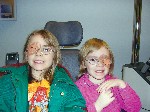 |
Q: How does the new amblyopia treatment study change the way we manage these kids?
A: Optometrists in clinical practice hear this question all the time: Is it too late to treat a lazy eye? This study definitely shows that its not too late, says optometrist Michael Gallaway, a vision therapy specialist whose private practice in Marlton, N.J., was one of the 49 research sites involved in the study.1 We now know that age should not be a factor in our clinical decision whether to treat amblyopia, he says. Families now have hope for older kids who have amblyopia.
The study specifically evaluated older kids, those from ages 7 to 17. Standard practice has held that eye doctors shouldnt bother to treat these kids because their amblyopia is already permanent. Its one of those time-honored clinical myths thats about to be busted, says Dr. Gallaway, who is also an associate professor at Pennsylvania College of Optometry.
The study examined 507 children ages 7 to 17 and randomly divided them into two groups: those fitted with prescription glasses alone and those given glasses, a regimen of eye patches or atropine drops, and assignments of near-work activities.
 |
| Children older than these may also benefit with glasses and/or patching. |
To the researchers surprise, as many as one in four of all the children showed an improvement of two lines or more of vision just by wearing prescription glasses.
Among those children ages 7 to 12 who wore glasses and a patch and participated in near-work activity, more than half improved. Of those in the 13 to 17 age group on the same protocol, one in four improved.
Also surprising, of the children ages 13 to 17 who had never been treated for amblyopia, nearly half of them who wore glasses and a patch and participated in near-work improved by two or more lines. This study provides a reason to put these older kids in glasses or contacts, Dr. Gallaway says, especially if they havent been treated before.
The study stops short of recommending a change to current clinical practice because the long-term data on whether the children retained visual improvement are not yet available. But if children do retain improvements in vision, we should find these kids and we should treat them more aggressively because there is hope, Dr. Gallaway says. We should even contact those patients who weve previously decided will not respond to treatment and let them know that the message is different now.
Also, the study begs the question: Why stop at 17? If we can show that amblyopia can be treated in this age group, whats to stop us from treating a 40-year-old with amblyopia? Dr. Gallaway says.
Q: In what way, if any, does this study affect our comanagement of amblyopic children?
A: This study has several implications in terms of comanagement. For one, it shows that pediatric ophthalmologists and pediatric optometrists can work together on a common goal and achieve substantial results. Its a great example of multidisciplinary cooperation, Dr. Gallaway says.
For another, he says, it underscores the need for primary-care eye doctors to change their mode of practice and refer older kids who have amblyopia to a qualified practitioner for further evaluation.
In addition, this study is a great reason for O.D.s who are comfortable managing amblyopia to reach out to any front-line health care practitioner who performs vision screenings, such as pediatricians, family doctors or school nurses. Im going to send this article to every pediatrician that I know near my practice, Dr. Gallaway says.
1. Scheiman MM, Hertle RW, Beck RW, et al. Randomized trial of treatment of amblyopia in children aged 7 to 17 years. Arch Ophthalmol 2005 Apr;123(4):437-47.

